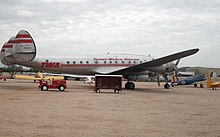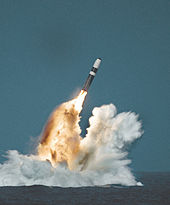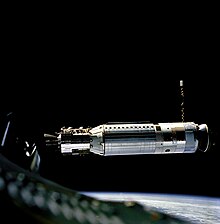Lockheed Corporation
Its founder, Allan Lockheed, had earlier founded the similarly named but otherwise-unrelated Loughead Aircraft Manufacturing Company, which was operational from 1912 to 1920.[4] On December 13, 1926, Allan Loughead, John Northrop, Kenneth Kay and Fred Keeler secured funding to form the Lockheed Aircraft Company (spelled phonetically to prevent mispronunciation) in Hollywood.[citation needed] The Lockheed Model 14 formed the basis for the Hudson bomber, which was supplied to both the British Royal Air Force and the United States military before and during World War II.The factory was hidden beneath a huge burlap tarpaulin painted to depict a peaceful semi-rural neighborhood, replete with rubber automobiles.The C-5 and L-1011 projects, the canceled U.S. Army AH-56 Cheyenne helicopter program, and embroiled shipbuilding contracts caused Lockheed to lose large sums of money during the 1970s.Others argued that the company should be allowed to go into bankruptcy citing the recent decision to leave Penn Central railroad to that fate, and the fact that the airbus program at issue was commercial rather than military.[24] Naval scholar Thomas Paul Stanton notes that the opposition to the bill held it was "the beginning of the socialization of the American aircraft and aerospace industry."[25] Treasury Secretary Connally pointed to the faltering economy and worries about unemployment while testifying "the time has come within the United States when we have to look at things differently."[25] Questions arose whether letting Lockheed fail would be bad for the market due to decreased competition or good by screening out inefficient competitors and mismanagement.This claim was denied by Comptroller General Elmer B. Staats, and efforts were made by Senator William Proxmire to get Treasury Secretary John Connally to testify due to the suspicion that the loan guarantee was in jeopardy.The editorial board of The New York Times blasted the situation, citing it as another argument against the propriety of the loan guarantee and the precedent it set for other failing companies.[27] The debate around the ramifications of the Lockheed loan guarantee soon resurfaced in late 1975 with discussions on possible aid to New York City during its fiscal crisis.[29] In 1976, it was publicly revealed that Lockheed had paid $22 million in bribes to foreign officials[30] in the process of negotiating the sale of aircraft including the F-104 Starfighter, the so-called Deal of the Century.[32] In the late 1980s, leveraged buyout specialist Harold Simmons conducted a widely publicized but unsuccessful takeover attempt on the Lockheed Corporation, having gradually acquired almost 20 percent of its stock.His board nominations included former Texas Senator John Tower, the onetime chairman of the Armed Services Committee, and Admiral Elmo Zumwalt Jr., a former Chief of Naval Operations.Lockheed products included the Trident missile, P-3 Orion maritime patrol aircraft, U-2 and SR-71 reconnaissance airplanes, F-117 Nighthawk, F-16 Fighting Falcon, F-22 Raptor, C-130 Hercules, A-4AR Fightinghawk and the DSCS-3 satellite.









LockheedAerospaceAllan LockheedMalcolm LockheedMartin MariettaLockheed MartinCalabasas, CaliforniaIrv CulverCourtlandt S. GrossRobert E. GrossWillis HawkinsHall HibbardKelly JohnsonAnthony LeVierJoseph F. Ware Jr.aerospace manufacturerLoughead Aircraft Manufacturing CompanyAllan LougheadMalcolm LougheadCaliforniaWorld War IJohn Northropspelled phoneticallyModel S-1Vega ModelBurbank, CaliforniaDetroit Aircraft CorporationGreat DepressionWalter VarneyairportAmelia EarhartWiley PostGeorge Hubert WilkinsModel 10 ElectraFred NoonanLockheed Model 12 Electra JuniorLockheed Model 14 Super ElectraHudsonWorld War IIImperial Japanese ArmyClarence (Kelly) JohnsonP-38 Lightningtwin-boomPearl HarborVictory over Japan DayU.S. Army Air ForcesAdmiral Isoroku Yamamotoassembly lineUnion AirportVenturasBoeing B-17 Flying FortressBoeingLockheed L-049 ConstellationTrans World AirlinesPima Air & Space MuseumTrans-World AirlinesL-049 ConstellationR6V ConstitutionConvairSkunk WorksLockheed U-2Soviet blocLockheed SR-71 BlackbirdLockheed C-130 HerculesLockheed P-80 Shooting StarMikoyan-Gurevich MiG-15Al CappLi'l AbnerPolarisF-104 StarfighterC-141 StarlifterC-5 GalaxyL-1011 TriStarwide-bodyMcDonnell Douglas DC-10Rolls-RoyceAH-56 CheyenneRichard NixonL-1011 Tristar airbusWilliam ProxmireAlan CranstonPenn Central railroadTreasury Secretary ConnallyHyman G. RickoverStephen J. WhitfieldLockeanSpiro T. AgnewElmer B. StaatsJohn ConnallyLockheed bribery scandalsbribesU.S. SenateFrank ChurchWest GermanyNetherlandsForeign Corrupt Practices ActL-1011leveraged buyoutHarold SimmonsCalifornia Public Employees' Retirement SystemDaniel M. TellepJohn TowerArmed Services CommitteeElmo Zumwalt JrGeorgia GulfNorth Bethesda, MarylandL-3 CommunicationsMartin Marietta MaterialsNorman R. AugustineTrident missileP-3 Orionmaritime patrol aircraftreconnaissance airplanesF-117 NighthawkF-16 Fighting FalconF-22 RaptorC-130 HerculesA-4AR FightinghawkTitan rocketsSandia National LaboratoriesSpace Shuttle External TankViking 1Viking 2Orbital Sciences CorporationAlco Hydro-Aeroplane CompanyRobert and Courtland Gross
